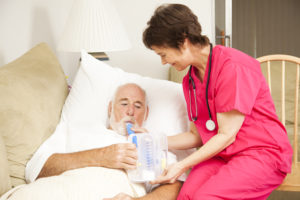
Chronic obstructive pulmonary disease (COPD) is a group of diseases that cause airflow blockage and breathing-related issues. Frequent coughing or wheezing is common, excess phlegm and mucus production, shortness of breath and trouble taking deep breaths. Almost 15 million Americans have been diagnosed with COPD, and even more Americans may be struggling with COPD and not even know it—more than 50% of adults who struggle with lung issues may be affected by the disease. A simple pulmonary lung function test performed in a clinic or doctor’s office can detect COPD in anyone with breathing problems.
What causes COPD?
• Tobacco smoke is a key factor in the development of COPD and its progression.
• Air quality plays a large role in development of COPD. Exposure to air pollutants in the home or workplace can be harmful to lungs.
• Untreated respiratory infections can lead to the development of COPD. Early detection of these conditions can help prevent COPD.
What are the risk factors?
• Smoking is a huge risk factor for COPD. In fact, most people who develop COPD are chronic smokers or are exposed to secondhand smoke regularly. While almost 90% of COPD cases are from smokers, nonsmokers can develop COPD as well.
• Long-term exposure to toxic chemicals and fumes, dust and air pollution can cause COPD.
• A small number of COPD patients have the disease because of an inherited condition called Alpha-1 deficiency. This is a protein that protects the lungs.
• Some areas of the country are more at risk for COPDs than others. COPD is actually more prevalent in rural areas than in metropolitan areas. Patients living in rural areas had more COPD-related hospitalizations and deaths than COPD patients living in cities.
How is it treated?
Treatment of COPD requires the supervision of a physician, but there are a few things you can do to help improve COPD symptoms:
• Quit smoking and avoid smoking and air pollutants. Ninety percent of COPD cases are tobacco smoke related, so quitting smoking and avoiding secondhand smoke can go a long way in reducing symptoms and flare-ups.
• Take medications to improve symptoms such as coughing and wheezing. A medication regimen administered and supervised by your physician is a smart idea to help control symptoms of COPD.
• Avoid lung infections by getting flu and whooping cough vaccines regularly—they are especially important to patients with COPD. Lung or respiratory infections should be treated with antibiotics or any other medication recommended by your doctor.
• Ask about pulmonary rehabilitation if necessary. A physician can personalized a treatment plan for you that include strategies to control COPD symptoms and improve your quality of life.
• Use supplemental oxygen if necessary. Some COPD patients may need to use a portable oxygen tank depending on the severity of their symptoms and their blood oxygen levels.
Living with COPD
Managing your COPD can be tricky, but with a physician’s help it can be managed. While you can take steps to avoid risk factors, like not smoking and avoiding polluted areas, there are some instances where you cannot control the environment and must deal with the effects of environment on your health. Hurricanes are natural disasters that often cause COPD flare-ups, due to the changing weather and lingering aftereffects of flooding. Take the following steps to protect yourself and prevent flare-ups during a hurricane by:
• Ensuring that you have electricity or a backup generator in case of a power outage. COPD patients who rely on supplemental oxygen in turn rely heavily on electricity for these machines. Create an emergency plan that includes having backup batteries or a backup plan to ensure you do not lose power or oxygen during a storm.
• Avoid mold during cleanup. Some molds are capable of producing toxins that can affect human lungs, making COPD symptoms worse or causing an infection. The best way to avoid getting sicker from mold is to prevent mold from getting into your lungs. Stay away from flooded buildings. If you must enter a building with mold for repairs, wear a respirator at all times.
• Try to reduce stress levels. Elevated anxiety and stress surrounding an impending or occurring storm can cause breathing issues even for non-COPD patients. Trouble breathing because of anxiety and stress can put pressure on an already tender respiratory system and make COPD symptoms worse. Try to take deep breaths as much as possible and avoid stress as much as you can. Being prepared for natural disasters like this can go a long way in helping you feel like you have some measure of control over the situation.
What do I do if I think I have COPD?
Visit your doctor to confirm if you have COPD or another lung condition. A simple pulmonary function test (PFT) can determine if you have COPD and how far the disease has progressed. If you are diagnosed with COPD, find support from fellow patients and local resources to help. Making sure you are on the right COPD medication, avoiding risk factors that make your COPD work, and working with your doctor regularly can improve your quality of life if you have COPD.
Disclaimer: The contents of this article, including text and images, are for informational purposes only and do not constitute a medical service. Always seek the advice of a physician or other qualified health professional for medical advice, diagnosis, and treatment.








